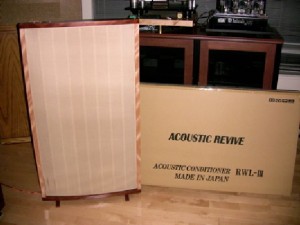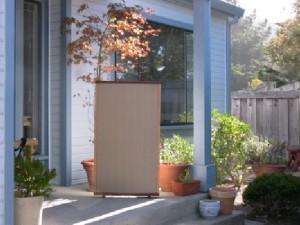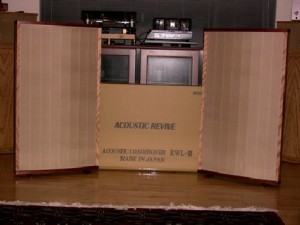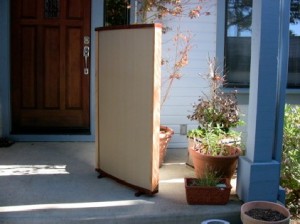Manufacturer:
SEKIGUCHI MACHINE SALES CO., LTD
- 3016-1Tsunatori-machi, Isesaki-shi, Gunma Pref. 372-0812
JAPAN
- TEL.+81-270-24-0878
- FAX. +81-270-21-1963
US Distributor: The Lotus Group
- Then click on Acoustic Revive to go to same site as above
- Retail price $995 (per panel)
- Dimensions: W665mm, D90mm, H1160mm, (Excludes
- Feet) / Weight: 6.2kg
- Self-standing feet and parts for wall mounting included
Written with special thanks to Yoshi Hontani (overseas exporter for Acoustic Revive)
- MuSon Project, Inc.
- No. 1-5-7 Nishi-Hommachi, Nishi-ku, Osaka 550-0005, Japan
Once again I am happily visiting the world of Acoustic Revive audio products. This company located in Isesaki, a small city within the Gunma prefecture on Honshu (main state or main island), is only 59 miles from Tokyo. Isesaki-shi has long been quite popular for its production of famous silk fabrics. As many of us know silk has been a desired product for centuries and it is suspected that the first silk fabrics were being made as early as 6000 BC. Some of the natural properties of silk are its strength, smooth texture and shimmering appearance. I mention this reference to silk because the product for review today is the Acoustic Revive RWL-3 Acoustic Conditioner Panel, which is based on a design philosophy using, amount other things, specially treated silk. I will talk more about this later in the review.
Acoustic Revive RWL-3 review
The theory behind the RWL-3 is that it diffuses reflection and sound coming from your speakers in an ideal manor with the aide of a special material ditch that was designed and constructed with varying depths to it. Acoustic Revive acknowledges that others before them have also tried to make proper acoustic panels to improve upon the sound and has the following to say about the subject:
“I`m sure that many people have listened to audio in a room which has expensive diffusing type room tuning which said to be analyzed by computer. People which who have listened to these room tuning must have experience sound such as pore sound position, corrupted sound stage and in a worst case, pore phase characteristics. This is because, unnecessary reflection occurs inside the room tuning random ditch and an outbreak of huge cross-modulation distortion stays inside the ditch.”
Acoustic Revive has done numerous studies involving both listening and computer analysis to help determine the correct ditch for its RWL-3’s. These tests helped them to create what they consider an ideal curved diffusion structure to improve phase characteristics in addition to solid sound positioning with a wider and deeper soundstage. Through the years the RWL panels have changed and evolved. Initially Acoustic Revive created the design but outsourced and manufactured the product elsewhere. Now the RWL is both designed and manufactured in Japan, as are all of their products. They feel that compared to the original panels the newest RWL-3 model is a greatly improved version.
Rather than trying to market an acoustic panel that absorbs they set out to build one that tunes and diffuses sound. Their belief that sound once absorbed is lost forever, therefore robbing it of its musicality, led them to try something different. The RWL-3 was built with the goal of eliminating reflection, flatter echo and standing waves in order to make the sound clearer while still retaining its natural energy and volume. Their website states that placing even just one panel in the center between two speakers will cause the listener to notice an improvement in the quality of sound coming from their audio system. Today we will test that statement.
Each panel is made with a high-tech natural silk and special foam material that contains Tourmaline. Tourmaline is designed to release negative ions that in turn help make the sound seem smoother and more enjoyable to listen to. For a moment let us look back to the September issue of Affordable Audio were I reviewed the Acoustic Revive RTP-2Ultimate power supply box. There I discussed the Ultimates use of Lithia Tourmaline powder, as well as other ingredients, to help eliminate both static and noise from the RTP-Ultimate. Tourmaline is also found in the Acoustic Revive RIO-5 II minus ion generator used to treat CD’s in order to create a more open sounding musical experience (October issue of Affordable Audio). As you can see Acoustic Revive seems to have a strong belief in the positive properties of Tourmaline, as it is a recurring element in some of their products. A high quality natural silk is used on the surface panel, as they feel silk is the only fiber that will help tame resonance, which is harmful to sound. Of further note is that the silk used has been taken from silkworms that were fed leaves coated with, you guessed it, Tourmaline powder. Thus the silk used with the panels has tourmaline naturally contained in it as well as the foam material used in the curved ditches. All these design efforts are made in order to have each RWL-3 release a strong negative ion. This negative ion is thought by them to improve sound wave transmission making for a clearer, higher resolution and higher quality tone effect.
Acoustic Revive makes many high-end audio products that are designed to enhance your audio experience. One other such product is there PSA-100 (Pure Silk Absorber). In order to remove the effects of static electricity that builds up around power supply cables and input or output terminals they recommend the use of this natural silk. Acoustic Revivie states that a small amounts of PSA-100 is all it takes to improve dynamics and transparency. At $55 for a box of this I intend to try some at a later date. Like I said earlier the Gunma prefecture is well known for its silk production and apparently the people at Acoustic Revive know just what to do with it.
Getting back to the RWL-3’s, the top, bottom and side panels as well as the feet are all made from a thick natural wood to help prevent the cabinet itself from resonating. By using natural wood Acoustic Revive found the sound quality to improve. I must say that both my wife and I found the RWL-3 to be an attractive alternative to mounting acoustical panels all over the walls and ceiling. The wood trim really set off the décor of the panel, as did the nice shimmering effect of the silk on the front. I had people over the house that thought I had bought some new attractive looking panel type speakers and did not realize what they were until I explained it to them.
I have heard a variety of acoustical products designed to treat various aspect of your room and have even tried a few do it yourself type projects. For those who are inclined to do so you may of course go online and find a great deal of information from people who have taken this path before you. For me I would much prefer taking all the knowledge gathered by the skilled people at Acoustic Revive to improve upon the sound of my audio system by alleviating problems stemming within the room. I say this after having three RWL-3’s in my listening room and experimenting with room placement first with one, then two and finally three RWL-3 panels. Looking to their website you will find numerous diagrams and multiple suggestions about where to place the panels. Setup and installation are both relatively easy. After unpacking the boxes all I had to do was screw two feet onto the bottom of each panel and I was ready to place it upright wherever needed. If after careful experimentation in your room you decide to go the way of placing them on the walls or ceiling, do not despair; the necessary mounting hardware is included with the purchase of each panel. Up on the wall and off the floor is indeed a very clean looking way to go. For myself though I had to keep them on the floor as I have two sets of speakers in the room for use as reviewing tools and therefore must move them depending on which set of speakers I am listening to. If I had two more I might have left those two on the wall nearest the Klipsch Klipschorn speakers and move the other three as needed for the Legacy Focus 20/20’s. Those with a dedicated room for listening might just prefer the wall mounting approach for the purpose of ascetics.
For now though let us talk about the various ways to place them within a room as suggested by Acoustic Revive. How you place them in your own home will of course depend on the shape of your room and placement of speakers/ furnishings within it. Those with non-conventionally shaped rooms should definitely experiment on their own a little more. I would like to share with you the following diagrams from Acoustic Revives website that were taken from http://www.acoustic-revive.com/english/rwl3/rwl3_02.html
To start out with I placed just one panel dead center between my two Legacy speakers, 18 inches to the rear of the back of the speakers, which in my room seemed a good spot to place them. For this listening test I decided to hear the Miles Davis, Kind of Blue vinyl album, as it is truly a classic piece of work. Accompanying him on that album were Julian “Cannonball” Adderly, Paul Chambers, James Cobb, John Coltrain, Bill Evans and Wynton Kelly. On first hearing the song “So What”, with one RWL-3 placed appropriately between the two Legacy speakers, I noticed that Miles Davis on trumpet was more pronounced and dead center in-between the speakers right where the panel was located. The sound from my system seemed to take on a better all around separation of individual instruments within the soundstage and actually felt like I had turned up the volume a bit. Perhaps I was now experiencing a cleaner sound, without some of the room interference, and that was why it seemed louder, While I do not know the scientific reason, it definitely felt like a positive improvement with just one panel placed in my room. I continually experimented with the panel by removing it and then placing it back again, over and over as I played different musical passages. Each time the same effect took place and it was clear to me that the RWL-3 was doing an excellent job of helping me with my rooms acoustics. For those on a budget even the addition of one panel should have the effect of making you smile at your wise purchase.
Now to make things more interesting I removed the center RWL-3 panel and placed one behind each speaker, again at an 18 inch distance behind the back of the Legacy Focus 20/20’s. I was now treated to more of the same effects, the main difference being that the soundstage seemed even wider and clearer. This two-panel placement really seemed to open everything up just a bit more for the better. The sound seemed fuller while at the same time clearer. I was able to play my music much louder whereas before I would get an echo effect in my room that was annoying. Remember my room has a cathedral ceiling as well as openings on two sides, which makes it a difficult room to fill with music. It had a noticeable slap echo effect, which I was wondering how to tame, before I meet the RWL-3 panels.
Lastly, I added the third RWL-3 back into the mix dead center between the other two panels, forming a line of three panels behind my Legacy’s. Now we were really getting somewhere as the three dimensional soundstage really open up. In my room though I preferred putting two panels to the left and right of me and one in the center between the two speakers because my room opens up to my dinning room behind the spot where I sit. Now with me partially blocking the music from escaping and two RWL-3 panels to either side more of the music stayed within the room. This was the best placement for my own personal situation but as all rooms are different your personal placement will change accordingly. Again listening to Miles Davis I now could hear quite clearly his marvelous trumpet emanating from the space between the speakers and the sense that the entire musical experience felt enriched. It was as if the room was emanating with music rather than just coming from the two speakers in front of me, an experience I definitely found to my liking. Next up was my Willie Nelson, Stardust album (the vinyl version). Wow did Willie Nelsons voice take on a commanding tone. I would say if the RWL-3 did one thing truly exceptional it seemed to tame negative effects within the midrange, which was particularly noticeable with voices. Not that other aspects of the musical experience were not improved, but with my system within my room, this was one change that I truly did stand up and applaud. The effect of having three panels within my room was felt by me to be a huge sonic improvement and worth the price of three RWL-3 panels.
I was now wondering how the panels would react to a horn-designed speaker placed in the corners. Therefore I decided to try the RWL-3’s with my Klipschorn speakers. I again started out with one placed dead center between the two, same place as it was with the Legacys. The angle of the Klipschorns did throw the sound out in front of and was not actually blocked by the RWL-3 panels. Hearing Rickie Lee Jones sing “Chuck E.’s In Love” the RWL-3 laid out a fuller, more spacious sound. I found the Klipschorns responding to just one panel in a positive way just like the Legacy’s’ did. I heard a fuller more robust sound when sitting in my listening seat. It was as if I had upgraded the source component itself, my turntable or cartridge. To test this a little further I finished the album and then moved onto a CD by James Taylor, New Moon Shine, since I am quite familiar with it. Same results, it did not matter whether vinyl or CD was playing as my source component. With just this one panel I was able to bring more focus and impact into my review system.
With my next step I removed the single panel and placed two panels at point of first reflection for the Klipschorns, placing one for each speaker near the listening position to the left and right but more in front of me. In order to keep things equal I decided to listen to the same music as I had previously with only one RWL-3 panel inserted into the loop. Again the sound changed. As I added more panels the sound within my room was becoming more alive with greater focus on individual instruments as was the layering of individual performers within the music, which was more pronounced and clear. This was a $995 upgrade from the first panel but one I could easily live with.
For my final step I left the two panels where they stood and added a third back to dead center between the two, same spot as I used for the Legacy’s. Again the soundstage took on a more focused presentation as voices were heard with even greater clarity then before. I felt the music sounded more dynamic and came across with greater impact. Especially noticeable were passages where I would listen to music with deep bass, sounding fuller giving a more life-like performance.
The RWL-3 panels are simply put, amazing! It returned the impact, transparency and details to the music that my room seemed to rob from it. I no longer felt that my system was limited by the room but rather that it was working together with it to allow the music to express itself in all its recorded glory. The question comes to mind not whether I should buy an RWL-3 panel but rather how many should I purchase. This question is as difficult to answer as asking yourself, when have I spent enough on my audio system and where should I stop? The answer to that will ultimately depend on you. I felt these panels from Acoustic Revive should be viewed as an integral part of the audio chain within my system. I regard it as I would a CD player or turntable and therefore equate its importance to that of source components themselves. For me it was three panels that took my breath away, although a forth or fifth would be a possibility I have not yet explored. Remember also Acoustic Revive makes a set of much smaller panels for wall use as well. These are called the WS-1’s and are made from the highest-grade silk material coming from the Hasegawa store, Japans largest silk wholesaler. Pricing is $185 each for a panel measuring 11.4 inch square x 1.25 inches thick. I would think this might be an alternative for those on a budget with rooms that are smaller and less difficult to tame. I certainly would not hesitate to try them as all the products from Acoustic Revive, that I have tested so far, have shone themselves to be superior and to perform as advertised.
As for the RWL-3 panels, I would start with a purchase of one panel and see where that takes you. At $995 it had an effect on the sound of my entire system and did something adding another component could not do, it improved upon my rooms acoustics. You can upgrade amps, preamps, turntables and the like but you still are listening to them within the context of your particular room. Until you improve upon that room you are not really hearing your systems full potential. You could be spending needless money upgrading equipment when really the culprit just might be the listening environment, yes your own room. I think I’ll let the good people at Acoustic Revive sum up the description of the RWL-3 panels quite nicely with the following quote from their website:
“Last evolution of room tuning panel with negative ion effect added which tunes and diffuses sound ideally!”
The Listening Environment
The listening room is 18 feet 8 inch long by 13 feet wide. Its cathedral ceiling starts at 8 feet high then slopes upward to 13 feet at its peak in the middle. Flooring is a soft hardwood covering with an oriental rug placed dead center in between (but not under) the listener and the audio system. There are no doors that open or shut into other rooms, also there are two large openings one facing the speakers and the other to its side and slightly in front of the right speaker. I have a nice comfortable marble fireplace opposite one opening and in front of the left speaker. As for my audio equipment it is tucked away nicely inside of a Cherry Synergy Twin S30 Salamander audio rack on the wall directly in front of me.
Review equipment:
- Monarchy Audio SM-70 Pro Amplifier
- Placette Passive Preamplifier
- Sony DVP-S7700 CD/DVD Player (used as transport only) Monarchy Audio Dual 20-Bit D/A Converter
- Acoustic Revive RD-3 Disc Demagnetizer and Rio-5 II Minus Ion Generator
- Oracle Delphi Mk I turntable with custom made interconnects
- Grace 707 tonearm with Denon 301 II MC cartridge Whest PhonoStage.20 + MsU.20 power supply Whest phono stage interconnects
- Klipsch Klipschorn speakers
- Legacy Focus 20/20 speakers
- Acoustic Revive RTP-4 Ultimate Power supply box
- PS Audio Power Port Receptacle Anti-Cable speaker wire 10 foot pair Anti-Jumpers for Legacy speakers
- PS Audio Transcendence Silver interconnects (2 pairs)
- Anti-Digital Interconnect single-shielded 1.5 meters in length
- Monarchy Audio AC-1 power cord one 6 foot length (2) Blue Circle BC86 MKIII power line pillows (2)
- Tek Line PC-8 Signature Power Cords 6-foot length
- Mr-Cable Musician power cord 9 foot length
- Cherry Synergy Twin S30 Salamander audio rack
from affordableaudio, By Anthony Nicosia




